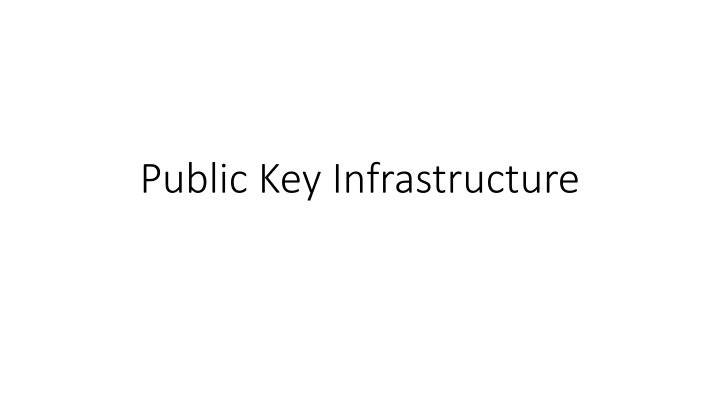
Encryption Techniques for Secure Communication
Explore the fundamentals of Public Key Infrastructure, Symmetric and Asymmetric Cryptography, Confidentiality, Key Exchange Protocols, and more. Learn about the hierarchy of Certificate Authorities, key threats, and methods to ensure data security in network communication.
Download Presentation

Please find below an Image/Link to download the presentation.
The content on the website is provided AS IS for your information and personal use only. It may not be sold, licensed, or shared on other websites without obtaining consent from the author. If you encounter any issues during the download, it is possible that the publisher has removed the file from their server.
You are allowed to download the files provided on this website for personal or commercial use, subject to the condition that they are used lawfully. All files are the property of their respective owners.
The content on the website is provided AS IS for your information and personal use only. It may not be sold, licensed, or shared on other websites without obtaining consent from the author.
E N D
Presentation Transcript
Content Prerequisites Public key infrastructure X509 and Openssl Domain name system Lab materials Issuing and Revoking Certificates Hierarchy of Certificate Authority Threat to Public Key Infrastructure
Symmetric Cryptography Enck( ) Enck( )
Symmetric Cryptography Encpk_A( ) Encpk_B( )
Key Exchange Protocols I will use the key Ok
Key Exchange Protocols EncpkA( )
Man in the Middle attack EncpkC( ) EncpkA( )
Certificate Give me your Public key and certificate is the certificate and public key
Transport Layer Security client hello, crypto info server hello, ciphersuite, certificate EncpkA(pre_master_key) Client finished Server finished Exchange message
x509 Standard format of public key certificates Used in TLS/SSL, electronic signature Self-signed or signed by certificate authority Certificate revocation list Path validation algorithm
Openssl CSR Entities Private keys
Openssl CSR Entities Private keys
Openssl CSR Entities Private keys
Sample commands Generate a Private Key and a CSR openssl req \ -newkey rsa:2048 -nodes -keyout domain.key \ -out domain.csr Generate a Self-Signed Certificate openssl req \ -newkey rsa:2048 -nodes -keyout domain.key \ -x509 -days 365 -out domain.crt Sign a certificate openssl x509 -req -days 360 -in <CSR-for-the-new-device> -CA <your-intermediate-CA-certificate> -CAkey <your- intermediate-CA-key> -out <your-new-certificate> - set_serial <a random number>
Domain names and IP addresses Go ask edu root Where www.cs.jhu.edu exactly is? Go ask jhu edu It is XX..XX jhu
Connect to DNS through DHCP and ARP Got a DHCP offer, the DNS server is
Issuing and Revoking Certificates Draw topology and reserve resources Set up LAMP for web application Set up Certificate Authority Generate certificate and configurate it Revoke the certificate
Hierarchy of Certificate Authority Basically the same as the previous one Replace a single CA with a chain of CA
Threat to Public Key Infrastructure Setup DNS server on attacker s node Setup web server on server s node Install tool-sslsplit on attacker s node Connect web server from client Check whether attacker did intercept messages
